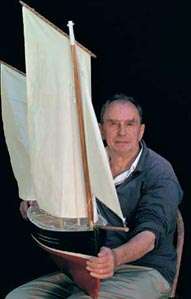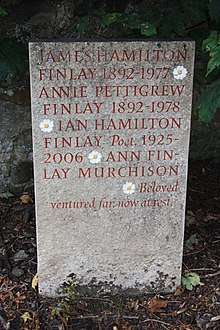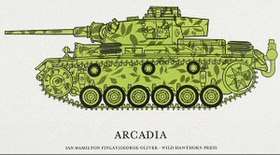Ian Hamilton Finlay
Ian Hamilton Finlay, CBE (28 October 1925 – 27 March 2006) was a Scottish poet, writer, artist and gardener.
Ian Hamilton Finlay | |
|---|---|
 Ian Hamilton Finlay at Little Sparta, 1994 | |
| Born | 28 October 1925 |
| Died | 27 March 2006 (aged 80) Edinburgh, Scotland |
| Nationality | Scottish |
| Known for | Poetry, concrete poetry, art, gardens, sculpture, publishing |
Notable work |
|

Life
Finlay was born in Nassau, Bahamas, to James Hamilton Finlay and his wife, Annie Pettigrew, both of Scots descent.
He was educated at Dollar Academy in Clackmannanshire and later at Glasgow School of Art. At the age of 13, with the outbreak of the Second World War, he was evacuated to family in the countryside. In 1942, he joined the British Army.[5] Finlay was married twice and had two children, Alec and Ailie. He died in Edinburgh.[6] He is buried with his parents and wife in Abercorn Churchyard in West Lothian. The grave lies in the extreme south-east corner of the churchyard.
Poetry
At the end of the war, Finlay worked as a shepherd, before beginning to write short stories and poems, while living on Rousay, in Orkney. He published his first book, The Sea Bed and Other Stories, in 1958, with some of his plays broadcast on the BBC, and some stories featured in The Glasgow Herald.[5]
His first collection of poetry, The Dancers Inherit the Party, was published in 1960 by Migrant Press with a second edition published in 1962. The third edition, published by Fulcrum Press (London) in 1969, included a number of new poems and was inaccurately described by the publisher as a first edition, which led to a complex legal dispute.[7] Dancers was included in its entirety in a New Directions annual a few years later.[8]
In 1963, Finlay published Rapel, his first collection of concrete poetry (poetry in which the layout and typography of the words contributes to its overall effect), and it was as a concrete poet that he first gained wide renown. Much of this work was issued through his own Wild Hawthorn Press, in his magazine Poor. Old. Tired. Horse.[9]
Finlay became notable as a poet, when reducing the monostich form to one word[10] with his concrete poems in the 1960s.[11] Repetition, imitation and tradition lay at the heart of Hamilton's poetry,[12] and exploring ' the juxtaposition of apparently opposite ideas'.[13]
Art
Later, Finlay began to compose poems to be inscribed into stone, incorporating these sculptures into the natural environment. This kind of 'poem-object' features in the garden Little Sparta that he and Sue Finlay created together in the Pentland Hills near Edinburgh. The five-acre garden also includes more conventional sculptures and two garden temples.
In December 2004, in a poll[14] conducted by Scotland on Sunday, a panel of fifty artists, gallery directors and arts professionals voted Little Sparta to be the most important work of Scottish art.[15] Second and third were the Glasgow School of Art by Charles Rennie Mackintosh and The Skating Minister by Henry Raeburn. Sir Roy Strong has said of Little Sparta that it is "the only really original garden made in this country since 1945".[16]
The Little Sparta Trust[17] plans to preserve Little Sparta for the nation by raising enough to pay for an ongoing maintenance fund. Richard Ingleby,[18] Ian Kennedy, Magnus Linklater, and Ann Uppington[19] are trustees. Former trustees include Ian Appleton, Stephen Bann, Stephen Blackmore,[20] Patrick Eyres,[21] , John Leighton, Duncan Macmillan, Victoria Miro, Paul Nesbitt and Jessie Sheeler.

Finlay's work is notable for a number of recurring themes: a penchant for classical writers (especially Virgil); a concern with fishing and the sea; an interest in the French Revolution; and a continual revisiting of World War II and the memento mori Latin phrase Et in Arcadia ego. His 1973 screenprint of a tank camouflaged in a leaf pattern, Arcadia, referring to the Utopian Arcadia of poetry and art (another recurring theme), is described by the Tate as drawing "an ironic parallel between this idea of a natural paradise and the camouflage patterns on a tank".[22]
His use of Nazi imagery led to an accusation of neo-Nazi sympathies and anti-semitism. Finlay sued a Paris magazine which had made such accusations, and was awarded nominal damages of one franc. The stress of this situation brought about the separation between Finlay and his wife Sue.[23]
Finlay also came into conflict with the Strathclyde Regional Council over his liability for rates on a byre in his garden, which the council insisted was being used as commercial premises. Finlay insisted that it was a garden temple.[24]
One of the few gardens outside Scotland to permanently display his work is the Improvement Garden in Stockwood Discovery Centre, Luton, created in collaboration with Sue Finlay, Gary Hincks and Nicholas Sloan.
Finlay was nominated[25] for the Turner Prize in 1985. He was awarded honorary doctorates from Aberdeen University in 1987, Heriot-Watt University in 1993[26] and the University of Glasgow in 2001, and an honorary and/or visiting professorship from the University of Dundee in 1999. The French Communist Party presented him with a bust of Saint-Just in 1991. He received the Scottish Horticultural Medal from the Royal Caledonian Horticultural Society[27] in 2002, and the Scottish Arts Council Creative Scotland Award[28] in 2003. Awarded in the Queen's New Year's Honours list in 2002, Finlay was a CBE.[29]
Finlay's work has been seen as austere, but also at times witty, or even darkly whimsical.
He is represented by the Wild Hawthorn Press, the Archive of Ian Hamilton Finlay, which works closely with the Ingleby Gallery (Edinburgh)[30] and the Victoria Miro Gallery (London) in the U.K.[31]
Collaborators
Finlay's designs were most often built by others.[5] Finlay respected the expertise of sandblasters, engravers and printers he worked with,[32] having approximately one hundred collaborators including Patrick Caulfield, Richard Demarco, Malcolm Fraser, Christopher Hall, Margot Sandeman. He also worked with a host of lettering artists including Michael Harvey and Nicholas Sloan.[33][34]
Printed works
|
|
Sculptures and gardens

A partial list of Finlay sculptures and gardens.[35][36] A few photographs are reachable through the external links.
- Little Sparta, (with Sue Finlay), Dunsyre, Lanarkshire, Scotland, 1966
- Canterbury sundial, Canterbury, England, University of Kent, near Rutherford College, 1972
- UNDA wall, Schiff, Windflower, Stuttgart, Germany, Max Planck Institute, 1975
- anteboreum, Yorkshire, England, private garden
- sundial, Liège, Belgium, University of Liège, 1976
- sundial, Bonn, Germany, British Embassy, 1979
- Five Columns for the Kröller-Müller, second title: A Fifth Column for the Kröller-Müller, third title: Corot – Saint-Just, tree-column bases named LYCURGUS, ROUSSEAU, ROBESPIERRE, MICHELET, COROT, Otterlo, Holland, Rijksmuseum Kröller-Müller, 1982
- a basket of lemons, a plough of the Roman sort, two oval plaques, Pistoia, Italy, Villa Celle, 1984
- Vienna, Austria, Schweizergarten, 1985
- Brittany, France, Domain de Kerguehennec, 1986
- Eindhoven, Holland, Van Abbemuseum, 1986
- A Remembrance of Annette, with Nicholas Sloan, Münster, Germany, Uberwasser Cemetery, 1987
- UNDA, with Sue Finlay and Nicholas Sloan, San Diego, Stuart Collection, 1987
- Furka Pass, Switzerland, 1987
- Strasbourg, France, Musée d'Art Moderne or Musée des Beaux-Arts, 1988
- Grove of Silence, Vincennes, with Sue Finlay and Nicholas Sloan, Forest of Dean, England, 1988
- Frechen-Bahem, Germany, Haus Bitz, 1988
- Preston, England, Harris Museum and Art Gallery, 1989
- Cologne, Germany, Ungers Private Library, 1990
- bridge columns, Broomielaw, Glasgow, Scotland, 1990
- Ovid wall, Aphrodite herm, tree-plaque, capital, with Nicholas Sloan, Luton, England, Stockwood Park, 1991
- tree-plaque, Hennef, Germany, private garden, 1991
- Lübeck, Germany, Overbeck-Gesellschaft, 1991
- Karlsruhe, Germany, Baden State Library, 1991
- Dudley, England, The Leasowes, 1992
- Six Milestones, The Hague-Zoetermeer, Holland, 1992
- Paris, France, private garden, 1993
- Frankfurt/Main, Germany, Schröder Münchmeyer Hengst & Co, 1994
- stone bench, stone plinth, three plaques. pergola, tree-plaque, others, Grevenbroich, Germany, 1995, named: Ian-Hamilton-Finlay-Park 2014[37]
- Foxgloves, with Peter Coates, Durham, UK, Botanical Gardens, 1996
- Shell Research Centre Thornton grounds, Finlay and Pia Simig with or for Latz+Partner, Chester, UK, 1997–
- paving, eight benches, tree plaque, with Peter Coates, Serpentine Gallery, Kensington Gardens, London, UK, 1997
- Fleur de l'Air, with Pia Simig, Peter Coates, Volkmar Herre, Harry Gilonis, John Dixon Hunt, Wild Hawthorn Press, Provence, France, 1997–2003
- Et In Arcadia Ego, with Peter Coates for Stroom, The Hague, Netherlands, 1998 (see Fashion, art, society in Camouflage)
- The Present Order, with Peter Coates, for Barcelona City Council, supported by The British Council, Barcelona, Spain, Park Güell, 1999
- with Peter Coates, Hamburg, Germany, 1999
- benches, with Peter Coates, Erfurt, Germany, Erfurt Federal Labour Court, 1999
- Cythera, with Peter Coates, Lanarkshire, Scotland, Hamilton Palace grounds, 2000
- Six Definitions, Dean Gallery grounds, Edinburgh, Scotland, National Galleries of Scotland, 2001
- Ripple with Peter Coates, Luxembourg, Casino Luxembourg, 2001 or 2002
- with Peter Coates, Neanderthal, Germany, 2002
- with Peter Coates, Carrara, Italy, Carrara International Biennale, 2002
- Basel, Switzerland, with Peter Coates, 2003
- with Peter Coates, St. Gallan, Switzerland, private residence, 2004
- seven Idylls, Dean Gallery allotments, Edinburgh, Scotland, Dean Gallery Allotments Association, 2005
- L'Idylle des Cerises with Pia Maria Simig (with Peter Coates), Ingleby Gallery, Edinburgh, Scotland, preparatory drawings and sculpture, 2005
Books by Finlay
- Finlay, Ian Hamilton (September–October 2004). Ken Cockburn; Lilias Fraser (eds.). The Dancers Inherit the Party and Glasgow Beasts, An' a Burd. Polygon in association with Scottish Poetry Library. ISBN 1-904598-13-7. Original: 1960 Migrant Press, 1961 Wild Hawthorn Press, 1961 Wild Flounder Press, 1969 Fulcrum Press, 1995 or 1996 or 1997 Polygon ISBN 0-7486-6207-3[38][39]
Bibliography
- Finlay, Ian Hamilton (September 2004). Ken Cockburn; Lilias Fraser (eds.). The Dancers Inherit the Party and Glasgow Beasts, An' a Burd. Polygon in association with Scottish Poetry Library. ISBN 1-904598-13-7. Original: 1960 Migrant Press, 1961 Wild Hawthorn Press, 1961 Wild Flounder Press, 1969 Fulcrum Press, 1995 or 1996 or 1997 Polygon ISBN 0-7486-6207-3
- Plenel, Edwy (13 May 1989). "Querelle d'artistes sur fond de bicentenaire Les douteuses provocations de M. Finlay" (in French). Le Monde. Retrieved 19 November 2006.
- Finlay, Ian Hamilton (18 November 2006) [acquired 1989, completed 27 February 1997, revised March 2004]. "Ian Hamilton Finlay papers 1948–1992, Getty Research Institute, Research Library, Accession no. 890144".
- Abrioux, Yves (15 December 2006). Ian Hamilton Finlay. A Visual Primer (N.e.of 2r.e. ed.). Reaktion Books. ISBN 0-948462-40-X. Original: 1992 MIT Press ISBN 9780262011297 or ISBN 0-262-01129-8
- Hendry, Joy; Alec Finlay (February 1997). Wood Notes Wild: Essays on the Poetry and Art of Ian Hamilton Finlay. Polygon. ISBN 0-7486-6185-9. Original: 1994 Chapman Publishing ISBN 0-906772-61-3
- Finlay, Ian Hamilton (1995). Zdenek Felix; Pia Simig (eds.). Works in Europe 1972–1995 Werke in Europa. Werner Hannappel (photographer). Cantz Verlag. ISBN 3-89322-749-0.
- Gillanders, Robin; Alec Finlay; Ian Hamilton Finlay (18 May 1999). Little Sparta: Portrait of a Garden. National Galleries of Scotland. ISBN 0-903598-85-X.
- Weilacher, Udo (September 1999). "Poetry in Nature Unredeemed – Ian Hamilton Finlay" (interview) in Between Landscape Architecture and Land Art. John Dixon Hunt (Foreword). Birkhauser. ISBN 3-7643-6119-0.
- Rashwan, Nagy; Ian Hamilton Finlay (December 2001). "The Death of Piety: Ian Hamilton Finlay in conversation with Nagy Rashwan". Jacket (15). ISSN 1440-4737. Retrieved 18 November 2006.
- Lubbock, Tom (August 2002). Susan Daniel-McElroy (ed.). Ian Hamilton Finlay: Maritime Works. Tate Gallery Publishing Ltd. ISBN 0-9539924-5-4.
- Tate St. Ives (2002). Ian Hamilton Finlay Maritime Works: Notes for Teachers (PDF). Archived from the original on 29 January 2006. Retrieved 11 November 2006.
- Finlay, Ian Hamilton (September 2004). Pia Simig; John Dixon Hunt (eds.). Fleur de l'Air: A Garden in Provence by Ian Hamilton Finlay. Volkmar Herre (photographer). Wild Hawthorn Press. ISBN 0-9548192-1-7. Retrieved 11 November 2006.
- Sheeler, Jessie (2003). Little Sparta, the Garden of Ian Hamilton Finlay. Andrew Lawson. Frances Lincoln. ISBN 0-7112-2085-9. Archived from the original on 5 February 2012. Retrieved 11 November 2006.
- Finlay, Ian Hamilton (2006). "The Lilly Library, Indiana University". Retrieved 18 November 2006.
- Finlay, Ian Hamilton (2006). "The National Archives of the UK (TNA): Public Record Office (PRO) GB/NNAF/P9981". Retrieved 19 November 2006.
See also
References
- Tate. "'Sea Poppy I [collaboration with Alistair Cant]', Ian Hamilton Finlay, 1966 – Tate". Retrieved 20 May 2017.
- Tate. "'Starlit Waters', Ian Hamilton Finlay, 1967 – Tate". Retrieved 20 May 2017.
- Tate. "'The Little Seamstress [collaboration with Richard Demarco]', Ian Hamilton Finlay, 1970 – Tate". Retrieved 20 May 2017.
- http://www.ianhamiltonfinlay.com/images/ihfcard/treeshells.jpg
- Johnson, Ken (31 March 2006). "Ian Hamilton Finlay, 80, Poet and Conceptual Artist, Dies". The New York Times. The New York Times Company. Retrieved 10 November 2006.
- McNay, Michael (29 March 2006). "Ian Hamilton Finlay". The Guardian. London: Guardian Newspapers Limited. Retrieved 10 November 2006.
- Finlay, Alec; Ian Hamilton Finlay (1996). The Dancers Inherit the Party and Glasgow Beasts. Edinburgh: Polygon. p. 7 (A Note on the Text).
- Finlay, Ian Hamilton (1968). "The Dancers Inherit The Party". New Directions in Prose and Poetry. New Directions Books (20). ISBN 9780811203319.
- Kettle's Yard Guide ,Cambridge 2008 ISBN 9781904561279
- Hirsch , Edward 'A Poets Glossary', Houghton Mifflin HRcourt ,Boston 2014 ISBN 9780151011957
- Perloff, Marjorie Review 'Dreams of Weeds' T L S London April 29, 2005
- Matsumoto, Lila 'Imitation, Reflection, Tradition: Some Reflections on the Poetry of Ian Hamilton Finlay' Forum Issue 15, University of Edinburgh Autumn 2012
- 'Beauty and Revolution : The Poetry and Art of Ian Hamilton Finlay' Kettle's Yard Exhibition Catalogue (Teachers Resource) Cambridge 2014
- http://scotlandonsunday.scotsman.com/index.cfm?id=1394292004%5B%5D
- Martell, Peter (5 December 2004). "Little Sparta goes a long way in poll on Scotland's greatest art". Scotland on Sunday. The Scotsman. Archived from the original on 3 May 2005. Retrieved 17 November 2006.
- Gibbons, Fiachra (30 June 2003). "Penniless poet's vision that bloomed". The Guardian. London: Guardian News and Media Limited. Retrieved 17 November 2006.
- "Little Sparta Trust website". www.littlesparta.co.uk. Retrieved 20 May 2017.
- "Ingleby Gallery". www.inglebygallery.com. Retrieved 20 May 2017.
- "Archived copy". Archived from the original on 11 March 2007. Retrieved 2006-11-17.CS1 maint: archived copy as title (link)
- "Royal Botanic Garden Edinburgh – Regius Keeper's message". www.rbge.org.uk. Archived from the original on 17 November 2007. Retrieved 20 May 2017.
- "New Arcadian Press". www.newarcadianpress.co.uk. Retrieved 20 May 2017.
- "Ian Hamilton Finlay: Arcadia (collaboration with George Oliver)". Arcadia, 1973. Tate. July 2008. Retrieved 11 May 2012.
- Craig (2010)
- The Times (28 March 2006). "Ian Hamilton Finlay: Scottish poet and artist who turned his Lanarkshire grounds into Little Sparta, a celebrated shrine to pacifism". Times Online. London: Times Newspapers Ltd. Retrieved 10 April 2007. and Jones, Jonathan (10 April 2007). "Signs of the times". The Guardian. London: Guardian Newspapers Limited. Retrieved 10 April 2007.
- "Turner Prize 1985 artists: Ian Hamilton Finlay – Tate". www.tate.org.uk. Retrieved 20 May 2017.
- webperson@hw.ac.uk. "Heriot-Watt University Edinburgh: Honorary Graduates". www1.hw.ac.uk. Retrieved 5 April 2016.
- "RCHS – Royal Caledonian Horticultural Society – Caley Scottish Gardening Society Scotland". www.royalcaledonianhorticulturalsociety.org. Archived from the original on 29 June 2008. Retrieved 20 May 2017.
- "Archived copy". Archived from the original on 8 October 2007. Retrieved 10 November 2006.CS1 maint: archived copy as title (link)
- The Little Sparta Trust (2006). "Ian Hamilton Finlay". Archived from the original on 5 March 2016. Retrieved 10 December 2006.
- "Ian Hamilton Finlay". Ingleby Gallery. Retrieved 23 March 2019.
Ingleby Gallery work closely with Finlay's Estate and holds a substantial selection from the archive of his Wild Hawthorn Press in stock.
- "Ian Hamilton Finlay". Victoria Miro Gallery. Retrieved 23 March 2019.
- Exhibition catalogue 'Beauty and Revolution: The Poetry and Art of Ian Hamililton Finlay' Kettle's Yard, Cambridge 2014
- Finlay, Ian Hamilton (2006). "Printed works". Wild Hawthorn Press. Retrieved 10 November 2006.
- Finlay, Ian Hamilton (2006). "Tate Collection". Retrieved 10 November 2006.
- Finlay, Ian Hamilton (1995). Zdenek Felix; Pia Simig (eds.). Works in Europe 1972–1995 Werke in Europa. Werner Hannappel (photographer). Cantz Verlag. ISBN 3-89322-749-0.
- Peter Coates (n.d.). "Biography: Collaborations with Ian Hamilton Finlay". Archived from the original on 12 January 2006. Retrieved 16 November 2006.
- "Ian-Hamilton-Finlay-Park". www.grevenbroich.de (in German). Retrieved 12 September 2018.
- The Trustees of Indiana University (n.d.). "IU Lilly Library". Retrieved 18 November 2006.
- Ingleby Gallery (n.d.). "Bookshop and Editions". Archived from the original on 22 May 2006. Retrieved 18 November 2006.
Sources
- University of Glasgow (September 2001). "Invitation to the Eleventh Jubilee Celebrations". Retrieved 11 November 2006.
- BBC News (31 December 2001). "Honours for Scotland". Retrieved 10 November 2006.
- Scottish Arts Council (2003). "Ian Hamilton Finlay CBE". Archived from the original on 8 October 2007. Retrieved 10 November 2006.
- Cooke, Rachel (14 August 2005). "Gardener's word". The Observer. London: Guardian News and Media Limited. Retrieved 17 November 2006.
- Craig, Cairns (2010). "Finlay, Ian Hamilton", in Oxford Dictionary of National Biography online, accessed 29 September 2016. (subscription required).
- University of Dundee (1 March 2006). "Duncan of Jordanstone Alumni Shine". Retrieved 11 November 2006.
- Hoyle, Ben (28 March 2006). "Ian Hamilton Finlay". Times Online. London: Times Newspapers Ltd. Retrieved 10 November 2006.
- Lubbock, Tom (29 March 2006). "Ian Hamilton Finlay". The Independent. London: Independent News and Media Limited. Archived from the original on 13 November 2006. Retrieved 10 November 2006.
- Tate Britain (2006). "Turner Prize History". Archived from the original on 26 September 2006. Retrieved 11 November 2006.
- Royal Caledonian Horticultural Society (2006). "Awards". Archived from the original on 29 December 2006. Retrieved 10 November 2006.
External links
| Wikiquote has quotations related to: Ian Hamilton Finlay |
- Ian Hamilton Finlay papers, 1948–1992, finding aid, Getty Research Institute.
- Finding aid to Ian Hamilton Finlay manuscripts at Columbia University. Rare Book & Manuscript Library.